Trifle
VerifiedAdded on 2023/06/03
|5
|1222
|231
AI Summary
This essay explores the themes of marriage and gender differences in Susan Glaspell's play Trifle. It highlights the role of women in uncovering the mystery surrounding Mr. Wright's demise and challenges the chauvinistic views of males towards females especially in a marriage.
Contribute Materials
Your contribution can guide someone’s learning journey. Share your
documents today.
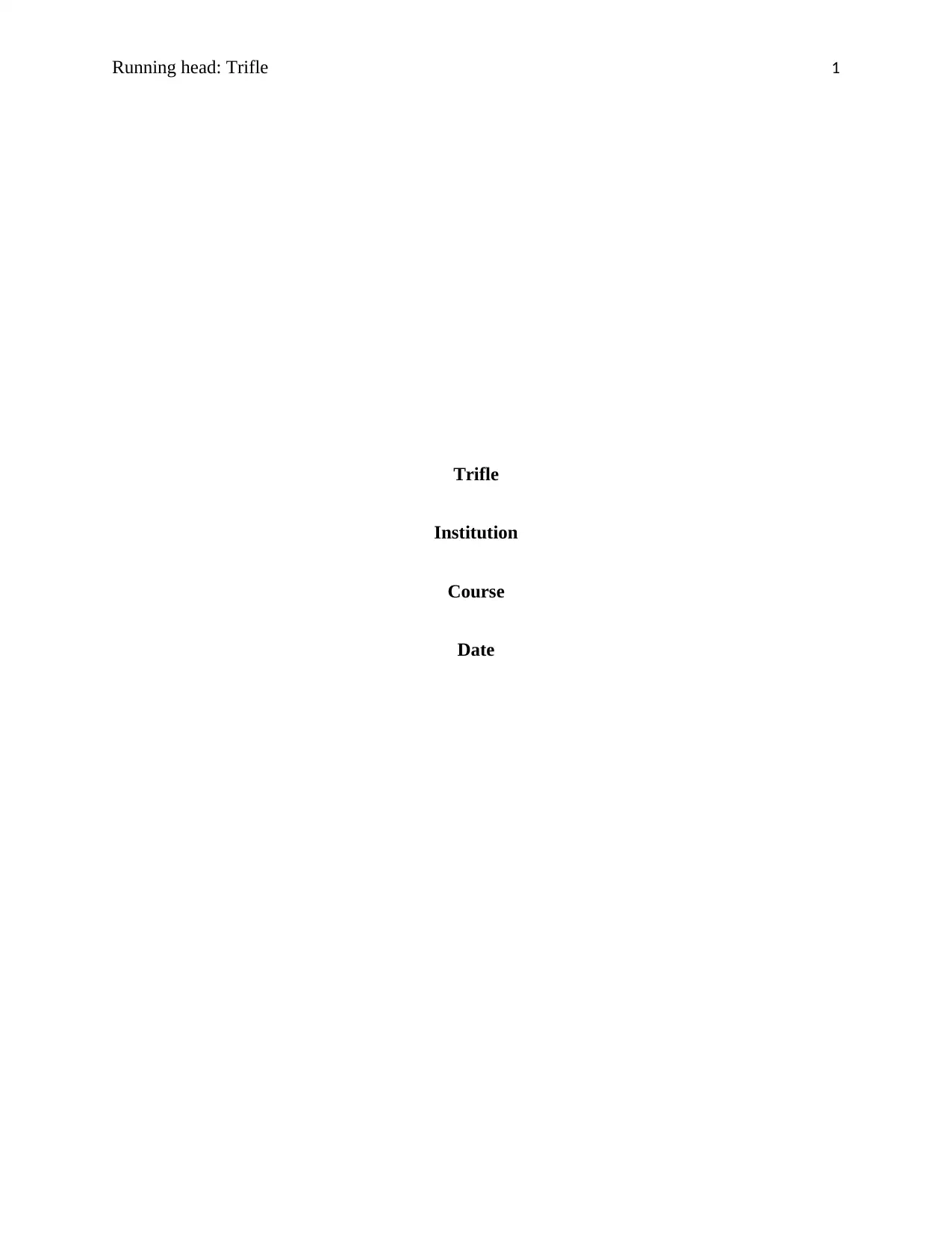
Running head: Trifle 1
Trifle
Institution
Course
Date
Trifle
Institution
Course
Date
Secure Best Marks with AI Grader
Need help grading? Try our AI Grader for instant feedback on your assignments.
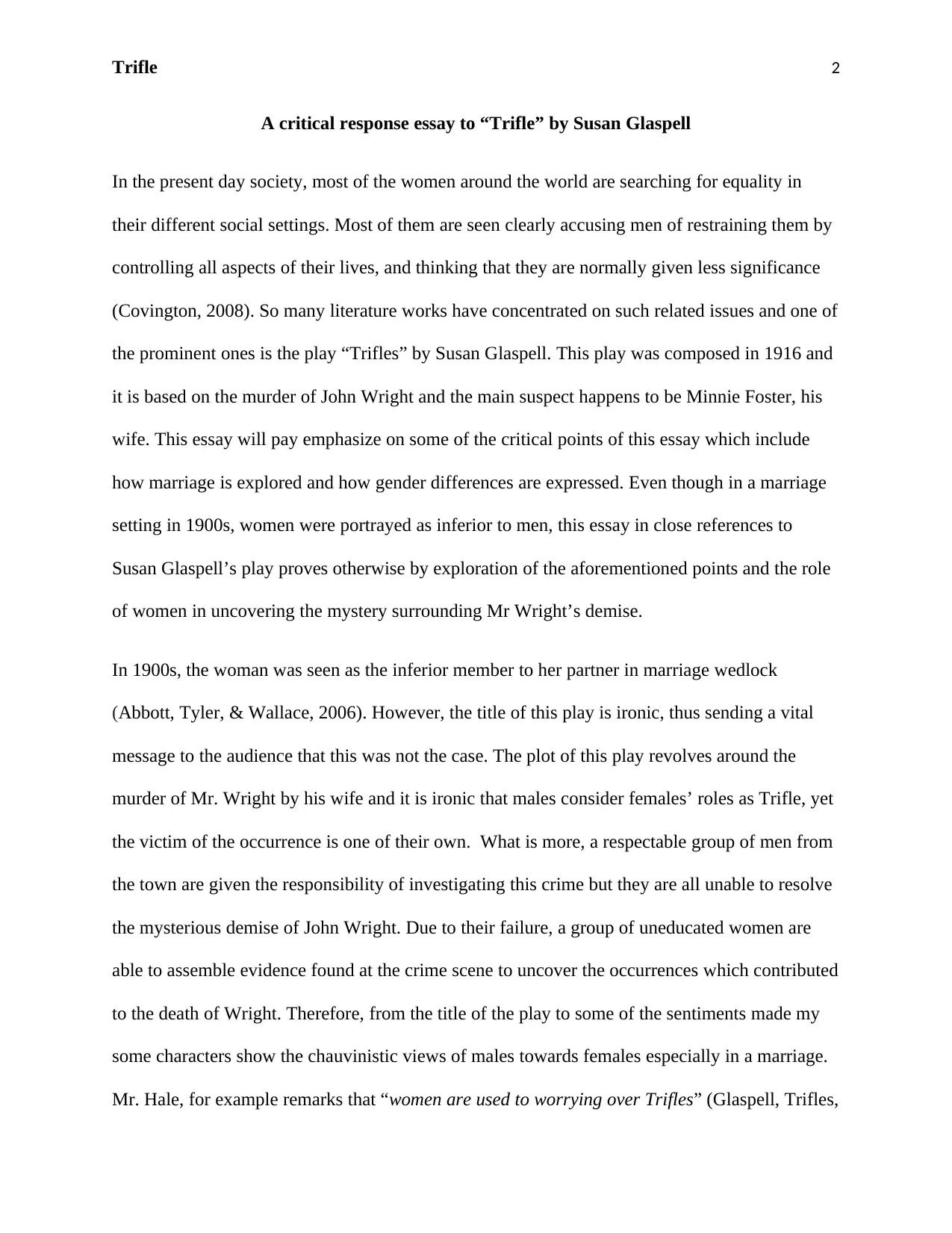
Trifle 2
A critical response essay to “Trifle” by Susan Glaspell
In the present day society, most of the women around the world are searching for equality in
their different social settings. Most of them are seen clearly accusing men of restraining them by
controlling all aspects of their lives, and thinking that they are normally given less significance
(Covington, 2008). So many literature works have concentrated on such related issues and one of
the prominent ones is the play “Trifles” by Susan Glaspell. This play was composed in 1916 and
it is based on the murder of John Wright and the main suspect happens to be Minnie Foster, his
wife. This essay will pay emphasize on some of the critical points of this essay which include
how marriage is explored and how gender differences are expressed. Even though in a marriage
setting in 1900s, women were portrayed as inferior to men, this essay in close references to
Susan Glaspell’s play proves otherwise by exploration of the aforementioned points and the role
of women in uncovering the mystery surrounding Mr Wright’s demise.
In 1900s, the woman was seen as the inferior member to her partner in marriage wedlock
(Abbott, Tyler, & Wallace, 2006). However, the title of this play is ironic, thus sending a vital
message to the audience that this was not the case. The plot of this play revolves around the
murder of Mr. Wright by his wife and it is ironic that males consider females’ roles as Trifle, yet
the victim of the occurrence is one of their own. What is more, a respectable group of men from
the town are given the responsibility of investigating this crime but they are all unable to resolve
the mysterious demise of John Wright. Due to their failure, a group of uneducated women are
able to assemble evidence found at the crime scene to uncover the occurrences which contributed
to the death of Wright. Therefore, from the title of the play to some of the sentiments made my
some characters show the chauvinistic views of males towards females especially in a marriage.
Mr. Hale, for example remarks that “women are used to worrying over Trifles” (Glaspell, Trifles,
A critical response essay to “Trifle” by Susan Glaspell
In the present day society, most of the women around the world are searching for equality in
their different social settings. Most of them are seen clearly accusing men of restraining them by
controlling all aspects of their lives, and thinking that they are normally given less significance
(Covington, 2008). So many literature works have concentrated on such related issues and one of
the prominent ones is the play “Trifles” by Susan Glaspell. This play was composed in 1916 and
it is based on the murder of John Wright and the main suspect happens to be Minnie Foster, his
wife. This essay will pay emphasize on some of the critical points of this essay which include
how marriage is explored and how gender differences are expressed. Even though in a marriage
setting in 1900s, women were portrayed as inferior to men, this essay in close references to
Susan Glaspell’s play proves otherwise by exploration of the aforementioned points and the role
of women in uncovering the mystery surrounding Mr Wright’s demise.
In 1900s, the woman was seen as the inferior member to her partner in marriage wedlock
(Abbott, Tyler, & Wallace, 2006). However, the title of this play is ironic, thus sending a vital
message to the audience that this was not the case. The plot of this play revolves around the
murder of Mr. Wright by his wife and it is ironic that males consider females’ roles as Trifle, yet
the victim of the occurrence is one of their own. What is more, a respectable group of men from
the town are given the responsibility of investigating this crime but they are all unable to resolve
the mysterious demise of John Wright. Due to their failure, a group of uneducated women are
able to assemble evidence found at the crime scene to uncover the occurrences which contributed
to the death of Wright. Therefore, from the title of the play to some of the sentiments made my
some characters show the chauvinistic views of males towards females especially in a marriage.
Mr. Hale, for example remarks that “women are used to worrying over Trifles” (Glaspell, Trifles,
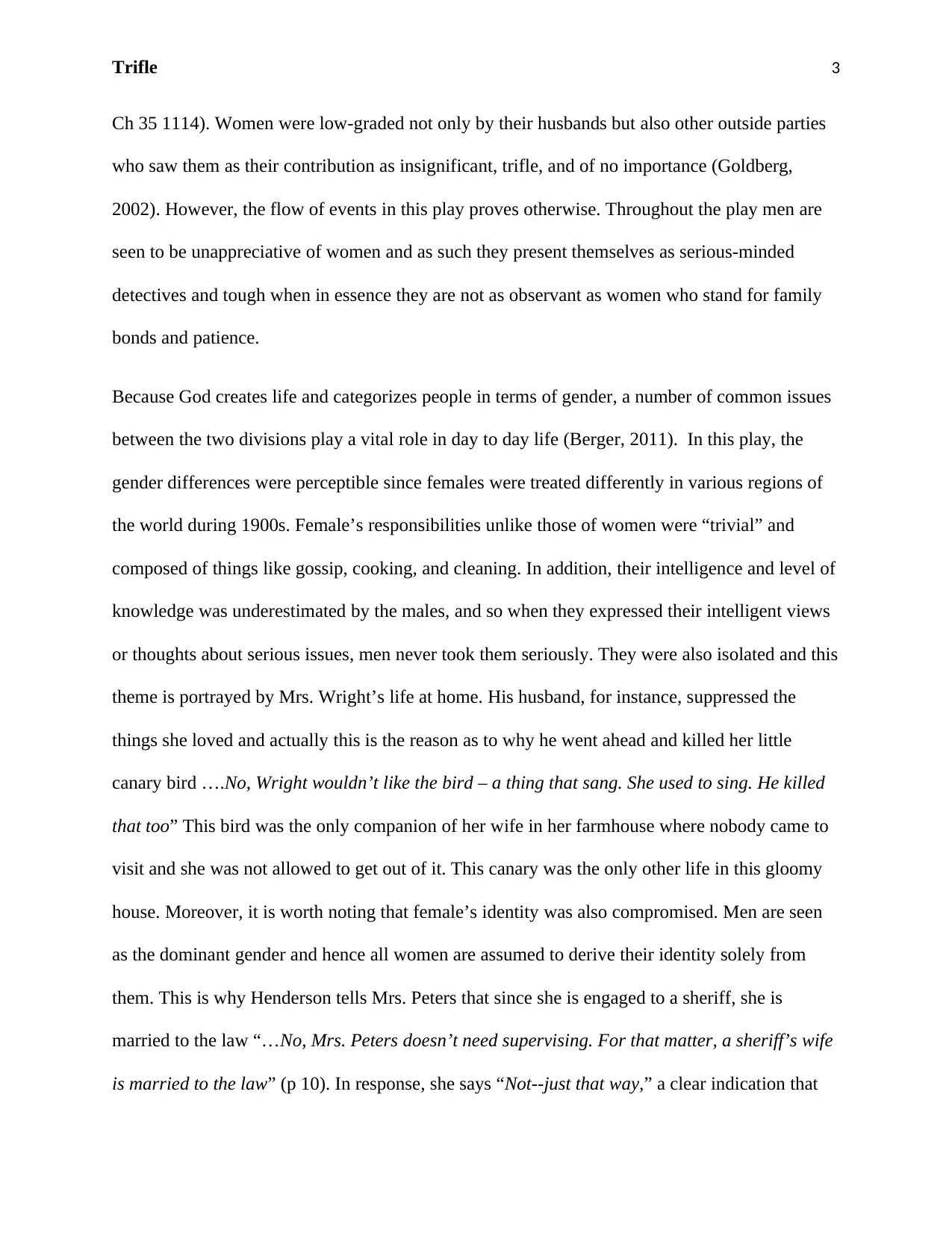
Trifle 3
Ch 35 1114). Women were low-graded not only by their husbands but also other outside parties
who saw them as their contribution as insignificant, trifle, and of no importance (Goldberg,
2002). However, the flow of events in this play proves otherwise. Throughout the play men are
seen to be unappreciative of women and as such they present themselves as serious-minded
detectives and tough when in essence they are not as observant as women who stand for family
bonds and patience.
Because God creates life and categorizes people in terms of gender, a number of common issues
between the two divisions play a vital role in day to day life (Berger, 2011). In this play, the
gender differences were perceptible since females were treated differently in various regions of
the world during 1900s. Female’s responsibilities unlike those of women were “trivial” and
composed of things like gossip, cooking, and cleaning. In addition, their intelligence and level of
knowledge was underestimated by the males, and so when they expressed their intelligent views
or thoughts about serious issues, men never took them seriously. They were also isolated and this
theme is portrayed by Mrs. Wright’s life at home. His husband, for instance, suppressed the
things she loved and actually this is the reason as to why he went ahead and killed her little
canary bird ….No, Wright wouldn’t like the bird – a thing that sang. She used to sing. He killed
that too” This bird was the only companion of her wife in her farmhouse where nobody came to
visit and she was not allowed to get out of it. This canary was the only other life in this gloomy
house. Moreover, it is worth noting that female’s identity was also compromised. Men are seen
as the dominant gender and hence all women are assumed to derive their identity solely from
them. This is why Henderson tells Mrs. Peters that since she is engaged to a sheriff, she is
married to the law “…No, Mrs. Peters doesn’t need supervising. For that matter, a sheriff’s wife
is married to the law” (p 10). In response, she says “Not--just that way,” a clear indication that
Ch 35 1114). Women were low-graded not only by their husbands but also other outside parties
who saw them as their contribution as insignificant, trifle, and of no importance (Goldberg,
2002). However, the flow of events in this play proves otherwise. Throughout the play men are
seen to be unappreciative of women and as such they present themselves as serious-minded
detectives and tough when in essence they are not as observant as women who stand for family
bonds and patience.
Because God creates life and categorizes people in terms of gender, a number of common issues
between the two divisions play a vital role in day to day life (Berger, 2011). In this play, the
gender differences were perceptible since females were treated differently in various regions of
the world during 1900s. Female’s responsibilities unlike those of women were “trivial” and
composed of things like gossip, cooking, and cleaning. In addition, their intelligence and level of
knowledge was underestimated by the males, and so when they expressed their intelligent views
or thoughts about serious issues, men never took them seriously. They were also isolated and this
theme is portrayed by Mrs. Wright’s life at home. His husband, for instance, suppressed the
things she loved and actually this is the reason as to why he went ahead and killed her little
canary bird ….No, Wright wouldn’t like the bird – a thing that sang. She used to sing. He killed
that too” This bird was the only companion of her wife in her farmhouse where nobody came to
visit and she was not allowed to get out of it. This canary was the only other life in this gloomy
house. Moreover, it is worth noting that female’s identity was also compromised. Men are seen
as the dominant gender and hence all women are assumed to derive their identity solely from
them. This is why Henderson tells Mrs. Peters that since she is engaged to a sheriff, she is
married to the law “…No, Mrs. Peters doesn’t need supervising. For that matter, a sheriff’s wife
is married to the law” (p 10). In response, she says “Not--just that way,” a clear indication that
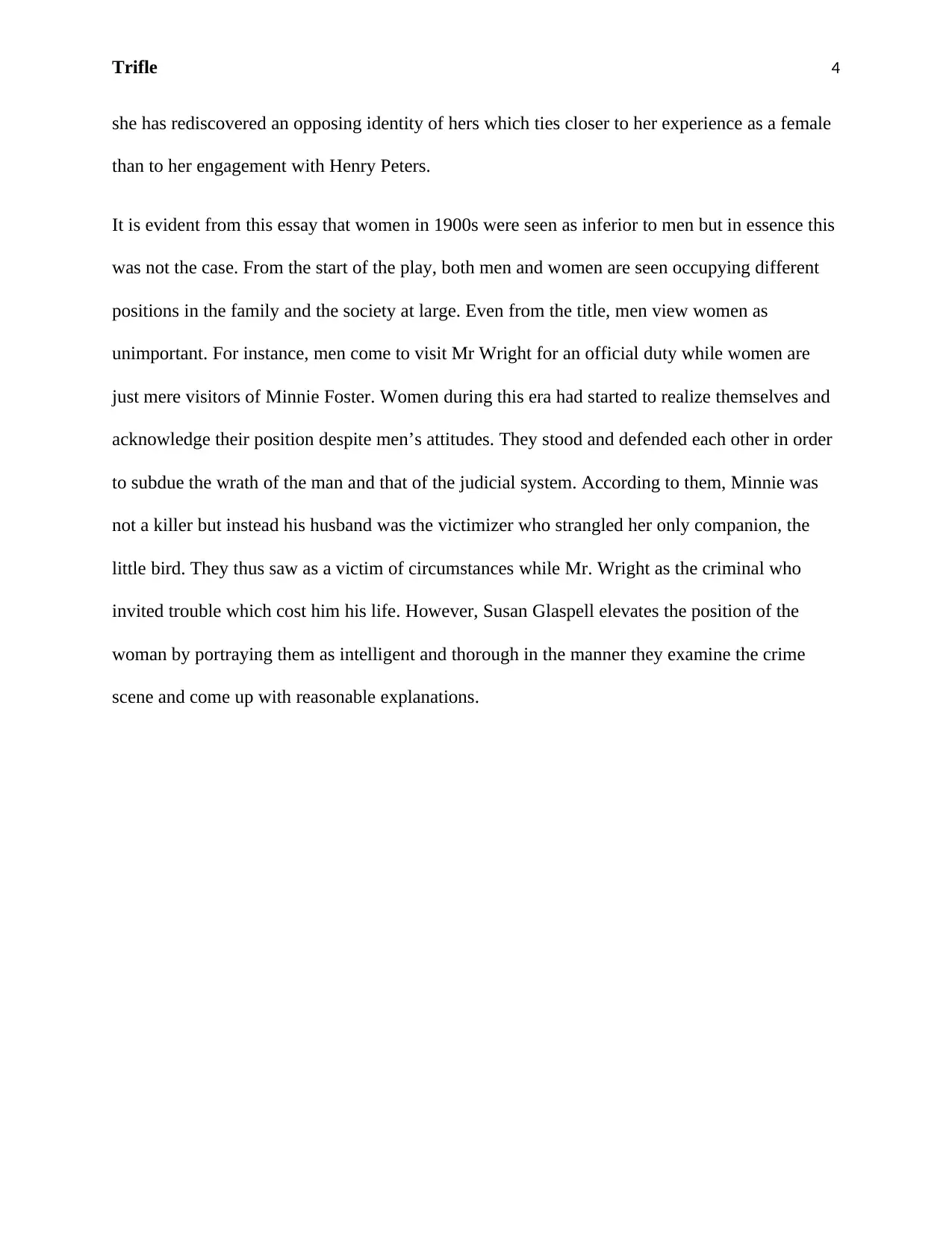
Trifle 4
she has rediscovered an opposing identity of hers which ties closer to her experience as a female
than to her engagement with Henry Peters.
It is evident from this essay that women in 1900s were seen as inferior to men but in essence this
was not the case. From the start of the play, both men and women are seen occupying different
positions in the family and the society at large. Even from the title, men view women as
unimportant. For instance, men come to visit Mr Wright for an official duty while women are
just mere visitors of Minnie Foster. Women during this era had started to realize themselves and
acknowledge their position despite men’s attitudes. They stood and defended each other in order
to subdue the wrath of the man and that of the judicial system. According to them, Minnie was
not a killer but instead his husband was the victimizer who strangled her only companion, the
little bird. They thus saw as a victim of circumstances while Mr. Wright as the criminal who
invited trouble which cost him his life. However, Susan Glaspell elevates the position of the
woman by portraying them as intelligent and thorough in the manner they examine the crime
scene and come up with reasonable explanations.
she has rediscovered an opposing identity of hers which ties closer to her experience as a female
than to her engagement with Henry Peters.
It is evident from this essay that women in 1900s were seen as inferior to men but in essence this
was not the case. From the start of the play, both men and women are seen occupying different
positions in the family and the society at large. Even from the title, men view women as
unimportant. For instance, men come to visit Mr Wright for an official duty while women are
just mere visitors of Minnie Foster. Women during this era had started to realize themselves and
acknowledge their position despite men’s attitudes. They stood and defended each other in order
to subdue the wrath of the man and that of the judicial system. According to them, Minnie was
not a killer but instead his husband was the victimizer who strangled her only companion, the
little bird. They thus saw as a victim of circumstances while Mr. Wright as the criminal who
invited trouble which cost him his life. However, Susan Glaspell elevates the position of the
woman by portraying them as intelligent and thorough in the manner they examine the crime
scene and come up with reasonable explanations.
Secure Best Marks with AI Grader
Need help grading? Try our AI Grader for instant feedback on your assignments.
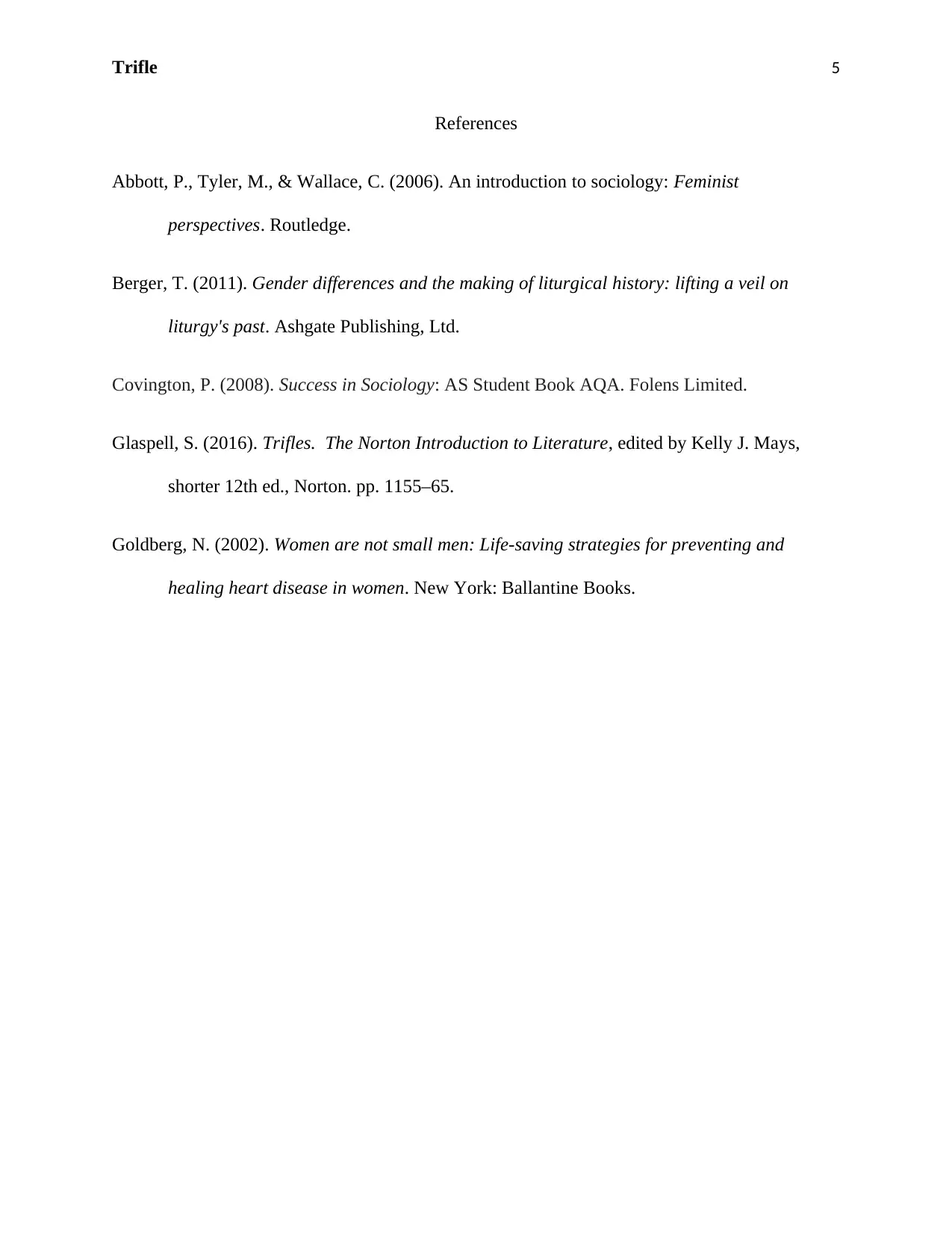
Trifle 5
References
Abbott, P., Tyler, M., & Wallace, C. (2006). An introduction to sociology: Feminist
perspectives. Routledge.
Berger, T. (2011). Gender differences and the making of liturgical history: lifting a veil on
liturgy's past. Ashgate Publishing, Ltd.
Covington, P. (2008). Success in Sociology: AS Student Book AQA. Folens Limited.
Glaspell, S. (2016). Trifles. The Norton Introduction to Literature, edited by Kelly J. Mays,
shorter 12th ed., Norton. pp. 1155–65.
Goldberg, N. (2002). Women are not small men: Life-saving strategies for preventing and
healing heart disease in women. New York: Ballantine Books.
References
Abbott, P., Tyler, M., & Wallace, C. (2006). An introduction to sociology: Feminist
perspectives. Routledge.
Berger, T. (2011). Gender differences and the making of liturgical history: lifting a veil on
liturgy's past. Ashgate Publishing, Ltd.
Covington, P. (2008). Success in Sociology: AS Student Book AQA. Folens Limited.
Glaspell, S. (2016). Trifles. The Norton Introduction to Literature, edited by Kelly J. Mays,
shorter 12th ed., Norton. pp. 1155–65.
Goldberg, N. (2002). Women are not small men: Life-saving strategies for preventing and
healing heart disease in women. New York: Ballantine Books.
1 out of 5
Related Documents
Your All-in-One AI-Powered Toolkit for Academic Success.
+13062052269
info@desklib.com
Available 24*7 on WhatsApp / Email
![[object Object]](/_next/static/media/star-bottom.7253800d.svg)
Unlock your academic potential
© 2024 | Zucol Services PVT LTD | All rights reserved.




